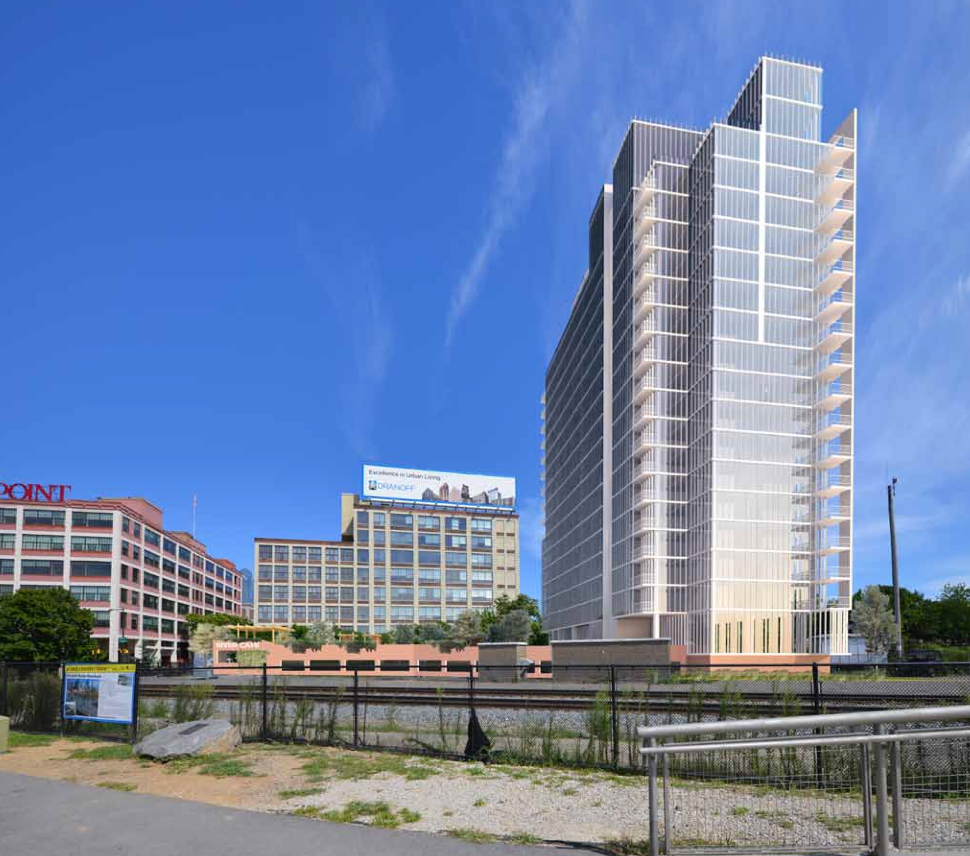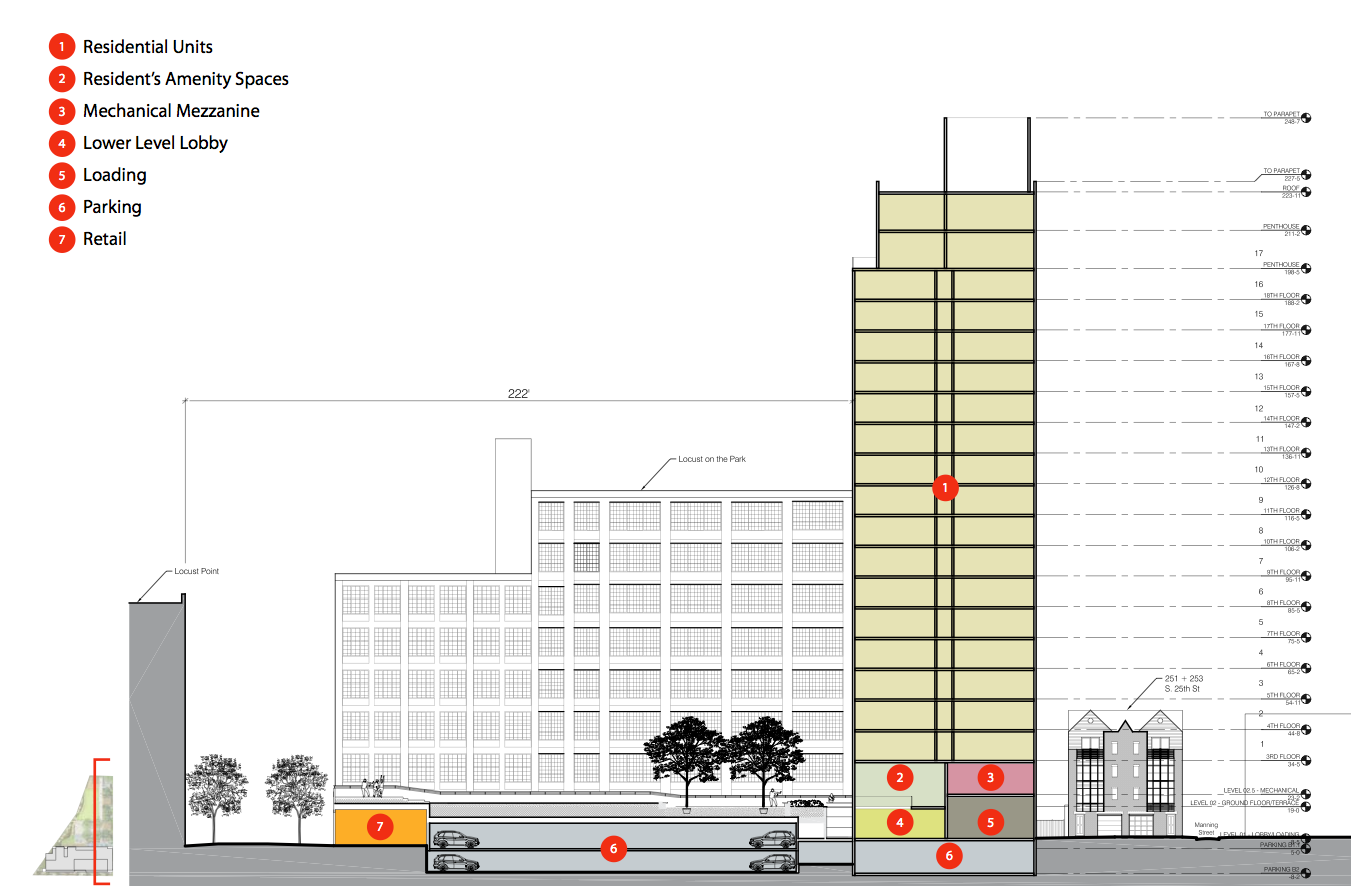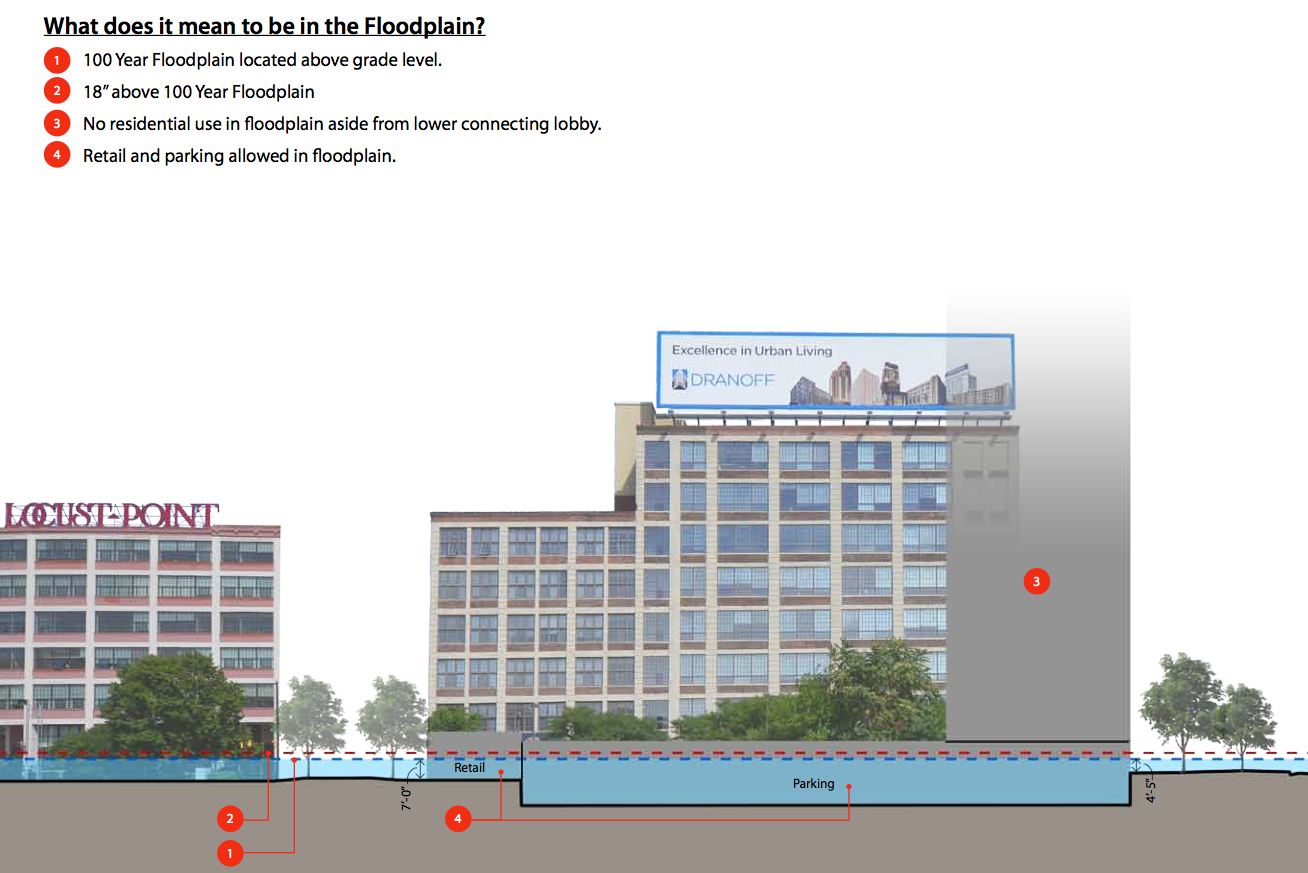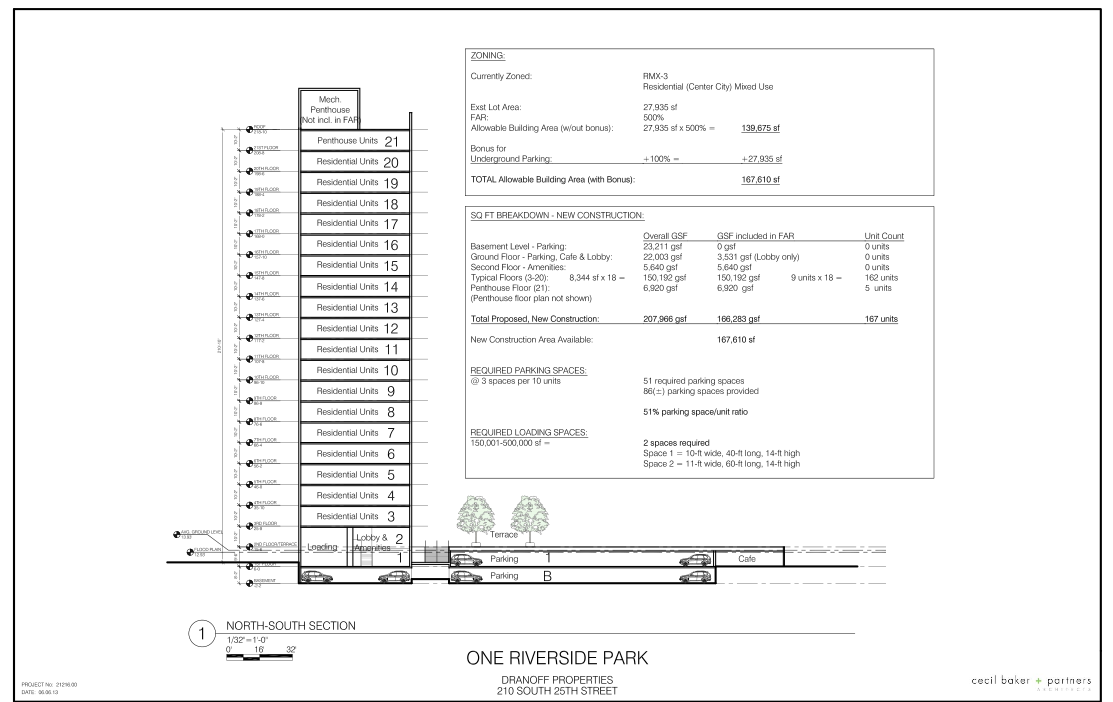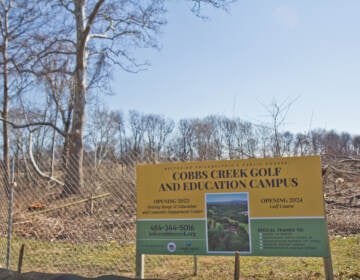L&I: Above ground garage at One Riverside may be legally viewed as below grade
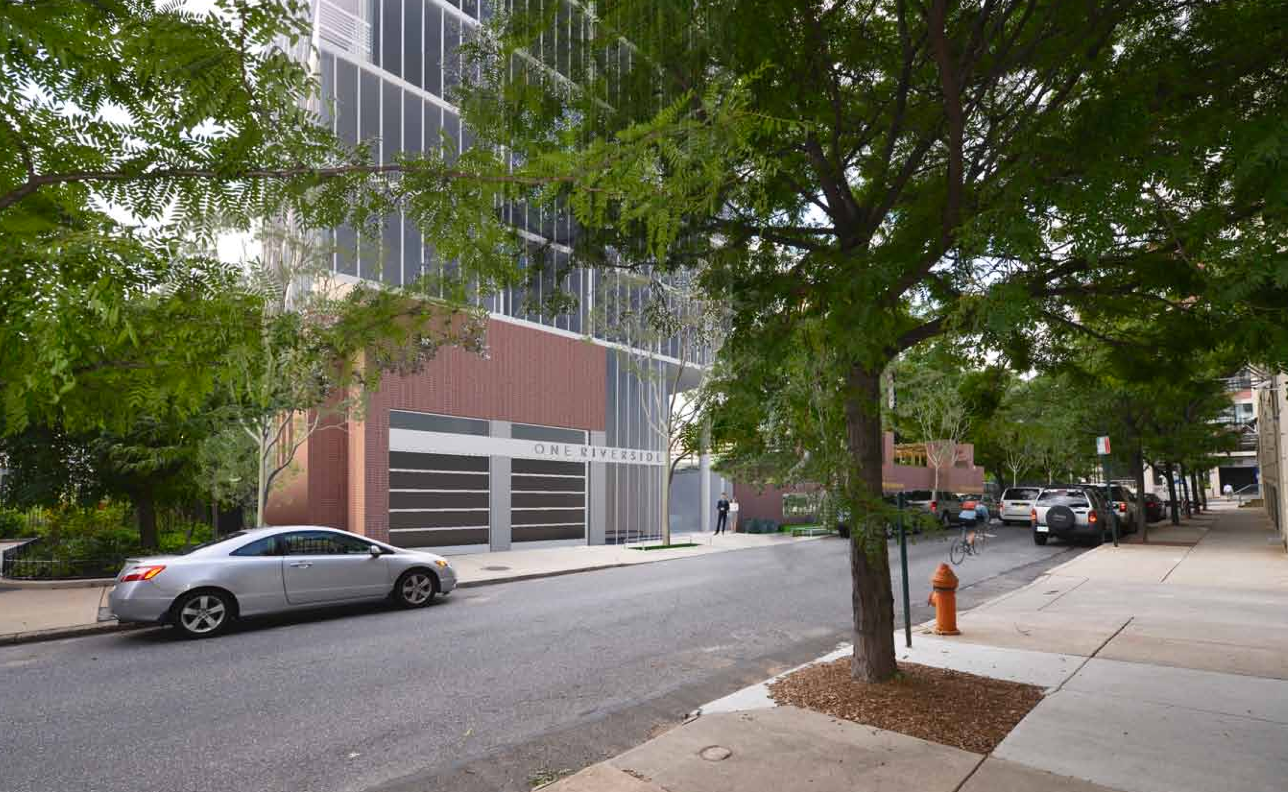
If a parking garage visibly sits at ground level, can it actually be underground parking?
Sometimes, yes, the city says.
And that answer has a group of waterfront advocates worried.
The above-ground underground garage is proposed as part of Carl Dranoff’s One Riverside Tower development, and will be the subject of an Oct. 23 Zoning Board of Appeals hearing.
Underground parking garages are one of the public benefits that a developer can provide to earn the right to build a denser project. The city’s Department of Licenses & Inspections granted Dranoff a floor area ratio bonus for his proposed 21-story apartment complex at 25th and Locust streets, near the Schuylkill River, based on it having an underground garage. The plans show a two-story garage. The lowest floor is literally in the earth. The second story, which also contains retail and a lobby, would sit at visible ground level. See more images here.
Resident Ted Reed claims that bonus was granted in error and filed an appeal, which brings us to the Oct. 23 hearing.
Attorney Paul Boni said it’s obvious that the intent of the bonus is to reward developers who keep parking literally out of the public eye, and the second floor of this parking would be visible. He adds the zoning rules say the bonus can only be granted if all parking is below grade.
“We look at the plan, and we say – this is not below ground parking, this is above ground parking. We can see it. It’s on grade, a one-story structure,” Boni said at this week’s meeting of the Central Delaware Advisory Group. Boni has been advising Reed and a group of other near-neighbors, and said he expects to be officially representing Reed once he returns from travels abroad. “How could this possibly be underground?”
According to L&I, the looks of a parking garage or other structure can be deceiving.
In response to questions on the project from the Planning Commission’s Civic Design Review committee, Zoning Examiner Sarah Kaiser detailed how in a Sept. 23 memo.
To simplify her response: When a structure is within a 100-year floodplain, the ground floor of the lot is one-foot above “regulatory flood level.”
The One Riverside project is within a 100-foot floodplain, and while the upper story of the garage is above ground, its height is lower than one-foot above the flood level. So therefore by code, the memo says, it is considered to be below ground level and qualifies for the bonus.
When asked for comment, Dranoff attorney Peter Kelsen said he couldn’t say much, since the matter is part of an on-going legal dispute. “The interpretation we believe is correct, L&I believes is correct, planning believes is correct. It is clearly stated in the code how to calculate the bonus in the floodplain.”
The city’s Chief Deputy Solicitor, Andrew Ross, said neither he nor anyone from the city could comment much, either, for the same reason. “The fact that (the bonus) was issued says that by the reading of the code we have, it meets a definition,” he said.
Boni argues that the floodplain regulations are in a separate part of the code from the height-bonus rules, and since the height-bonus rules do not refer to the other section, “the undefined phrase ‘below grade’ must be given its plain meaning.’”
Boni spoke to CDAG members in hopes of convincing them this issue should be of concern to waterfront advocates along both the Schuylkill and Delaware Rivers. He succeeded.
CDAG’s mission is to defend the Master Plan for the Central Delaware, which calls for a reduction in surface parking.
If the L&I decision stands, a developer who otherwise had no intention of building a parking garage is incentivised to do so.
“We could end up with parking garages, albeit low parking garages, proliferated all over our waterfronts.”
CDAG Chairman Matt Ruben noted the master plan attempts to discourage buildings sitting atop a parking podium.
Vice chair Joe Schiavo asked if there needed to be a legislative fix to add clarity to the code.
“No, I don’t think there’s a problem,” Boni said. “I think it’s pretty darn clear. I think the city is just making a bone-headed mistake.”
CDAG members decided to write a letter to planning and other officials addressing the issue of ground-level structures being considered below-grade on the city waterfronts, but will have more discussion as to whether they want to take a position on the Dranoff case in particular.
Ruben noted that normally they would not, since the project wouldn’t be located within the Central Delaware, but if CDAG decided this specific case would set an important precedent that could be detrimental to the Central Delaware, they could.
Member Phillip Stoltzfus suggested that Boni could reference the CDAG letter, even if it did not specifically mention this case.
Member Dianne Mayer said either way, the letter should go out before the hearing, “otherwise, precedent could already be set.”
A call seeking comment from Schuylkill River Development Corporation President and CEO Joseph Syrnick about his views on how the floodplain below grade definition could impact the river was not immediately returned. It should be noted that Syrnick sits on the city planning commission.
Thomas Corcoran, president of the Delaware River Waterfront Corporation, said he did not know enough about the situation at this time to comment on it, but he was seeking more information.
WHYY is your source for fact-based, in-depth journalism and information. As a nonprofit organization, we rely on financial support from readers like you. Please give today.



